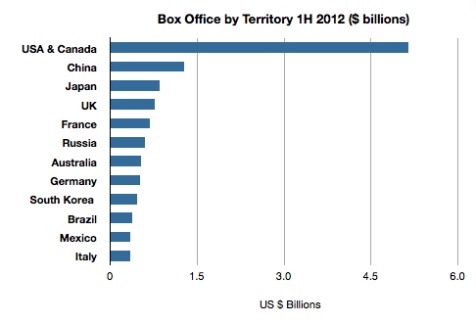by Robert Cain for China Film Biz
July 29, 2012
With their import quotas, foreign film blackouts, and other methods of market management, SARFT and the PRC government have made it abundantly clear that protection of local films and producers is a major Chinese policy goal.
Since Chinese protectionism is unlikely to go away, U.S. and other foreign producers who seek to participate in China’s booming film business will need to start engaging more with local Chinese companies.
There are several thousand licensed production companies in China (more than 1,500 in Beijing alone), so outsiders need systematic ways to narrow their lists of potential collaborators down to manageable size. One such method is to measure companies by their respective market shares. That’s my purpose here.
I’ve listed below China’s top production companies by their market share during the first 7 months of 2012. In calculating market share I’ve attributed each Chinese language film to a single production company, even though in some cases there were as many as 15 production companies credited on a single film. In such cases I’ve attributed credit for the film only to the company that received the first position credit. Co-productions with foreign companies are attributed to the mainland Chinese partner.
 Source: Pacific Bridge Pictures research
Source: Pacific Bridge Pictures research
Here’s more detail on the top five:
Ningxia Film Group
Ningxia Film Group is the official government owned production company of Ningxia Autonomous Region, a tiny northern Chinese province that borders Inner Mongolia. The company landed at the top of this list by virtue of a single film, Painted Skin: The Resurrection, the only film it has ever produced. Ningxia’s President, Hong Yangtao explained that he had only one chance at making a movie: “We shot this film to survive.” His strategy for producing and launching Painted Skin 2 has resulted in mainland China’s most successful film ever, so it’s very possible that Ningxia may avoid the fate of becoming a one-hit wonder.
China Film Group
With all of its financial strength, distribution clout, and government influence, it’s surprising that China Film Group’s production division has managed only a 3 percent share of its home market this year, far less than any one of the Hollywood studios have captured in China. The Beijing-based company is a government-owned behemoth that is far more influential in the distribution sphere, where it has played a role in releasing 19 of the top 20 grossing films of 2012. Under its Chairman Han Sanping, CFG is preparing for an upcoming IPO.
Huayi Brothers
China’s most powerful independent (i.e., non state-owned) entertainment conglomerate, Beijing-based Huayi Brothers is a diversified company engaged in film and TV production, distribution, theatrical exhibition, and talent management. Huayi Brothers trades on the Shenzhen stock exchange at a market capitalization of US $1.5 billion. The company’s Wang Brothers are skilled at attracting top directors, and they consistently rank among China’s market share leaders. If any Chinese company can challenge Hollywood’s studios for market dominance in China, Huayi Brothers is certainly a top contender.
Bona Film Group
Like Huayi Brothers, Beijing based Bona Film Group is also an independent, publicly traded company engaged in both production and distribution of films. Trading on the US NASDAQ exchange, Bona’s current market capitalization is US $345 million. Under President Yu Dong the company has been a reliable supplier of blockbuster hits in recent years, and usually captures at least a 10 percent share of the domestic market. Bona is one of the more internationally-oriented Chinese companies, with interests in Hong Kong and the United States, and is now 20 percent owned by News Corp. Look to Bona to be one of the next producers of a crossover hit that breaks out internationally.
Enlight Media
Under CEO Wang Changtian, Enlight Media rarely mis-fires in its production and distribution of feature films. Squarely focused on the action and romance genres, Enlight usually places several films in China’s top 20 grossers, and currently has in release the country’s fourth highest-grossing Chinese language film, The Four. Enlight is also a major player in China’s TV series production and distribution businesses. Under the leadership of its CEO Wang Changtian, the publicly traded, Beijing-based company has achieved a market capitalization of nearly US $1 billion.
Companies that didn’t make the top 15 ranking above but that are worthy of mention include Shanghai Toonmax, Stellar Pictures, Xiaoxiang Film Group, Henan Film Studios, DMG Entertainment, and Dadi Films.
Too many production companies are competing in China for scarce resources—and for even scarcer quality scripts. If the PRC’s film regulators are serious about making their domestic industry more competitive, they should focus less on protectionist measures and more on encouraging consolidation and cooperation among the industry’s disparate players.
Robert Cain is a producer and entertainment industry consultant who has been doing business in China since 1987. He can be reached at rob@pacificbridgepics.com and at www.pacificbridgepics.com.
















